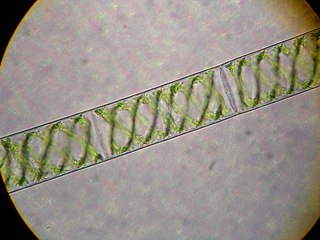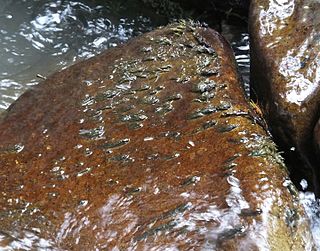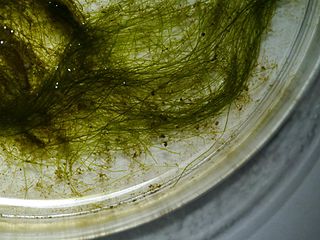
Chlamydomonadales, also known as Volvocales, are an order of flagellated or pseudociliated green algae, specifically of the Chlorophyceae. Chlamydomonadales can form planar or spherical colonies. These vary from Gonium up to Volvox. Each cell has two flagella, and is similar in appearance to Chlamydomonas, with the flagella throughout the colony moving in coordination.

Spirogyra is a genus of filamentous charophyte green algae of the order Zygnematales, named for the helical or spiral arrangement of the chloroplasts that is characteristic of the genus. Spirogyra species, of which there are more than 400, are commonly found in freshwater habitats. Spirogyra measures approximately 10 to 100 μm in width and may grow to several centimetres in length. It is often observed as green slimy patches on the ground near ponds and other water bodies having stagnant water.

Oedogonium is a genus of filamentous, free-living green algae. It was first discovered in the fresh waters of Poland in 1860 by W. Hilse and later named by German scientist K. E. Hirn. The morphology of Oedogonium is unique, with an interior and exterior that function very differently from one another and change throughout its life cycle. These protists reside in freshwater ecosystems in both hemispheres and are both benthic and planktonic in nature. As they form algal patches on the water's surface, they interact closely with a multitude of other algae. These filamentous cells' life cycles include both sexual and asexual reproduction, depending on the life cycle stage. Although quite common, Oedogonium is difficult to identify since key ID factors are only present during reproduction, which is an uncommon life stage among this genus. Oedogonium has been found to be important in the fixation of heavy metals in freshwater ecosystems.

Micrasterias is a unicellular green alga of the order Desmidiales. Its species vary in size reaching up to hundreds of microns.

Porphyra is a genus of coldwater seaweeds that grow in cold, shallow seawater. More specifically, it belongs to red algae phylum of laver species, comprising approximately 70 species. It grows in the intertidal zone, typically between the upper intertidal zone and the splash zone in cold waters of temperate oceans. In East Asia, it is used to produce the sea vegetable products nori and gim. There are considered to be 60 to 70 species of Porphyra worldwide and seven around Britain and Ireland where it has been traditionally used to produce edible sea vegetables on the Irish Sea coast. The species Porphyra purpurea has one of the largest plastid genomes known, with 251 genes.

Chordariaceae is a family of brown algae. Members of this family are may be filamentous, crustose with fused cells at the base, or they may be terete and differentiated into a central medulla and an outer photosynthetic cortex. They have a sporphytic thallus usually aggregated to form a pseudo-parenchyma.

Lemanea is a genus of freshwater red algae, in the order Batrachospermales. Both species are considered to be widespread in the northern hemisphere. Although placed in the Rhodophyta it in fact is green in colour.
Oocystaceae is a family of green algae, in the order Chlorellales. The type genus is Oocystis.

The Desmidiaceae are one of four families of charophyte green algae in the order Desmidiales (desmids).

Zygnematophyceae is a class of green algae in the paraphylum streptophyte algae, also referred to as Charophyta, consisting of more than 4000 described species. The Zygnematophyceae are the sister clade of the land plants.

The Delesseriaceae is a family of about 100 genera of marine red alga.

Halymenia a genus of a macroscopic red algae that grows in oceans worldwide.

Vaucheria is a genus of Xanthophyceae or yellow-green algae known as water felt. It is one of only two genera in the family Vaucheriaceae. The type species of the genus is Vaucheria disperma.

Scytonema is a genus of photosynthetic cyanobacteria that contains over 100 species. It grows in filaments that form dark mats. Many species are aquatic and are either free-floating or grow attached to a submerged substrate, while others species grow on terrestrial rocks, wood, soil, or plants. Scytonema is a nitrogen fixer, and can provide fixed nitrogen to the leaves of plants on which it is growing. Some species of Scytonema form a symbiotic relationship with fungi to produce a lichen.
Bangia is an extant genus of division Rhodophyta that grows in marine or freshwater habitats. Bangia has small thalli with rapid growth and high reproductive output, and exhibits behavior characteristic of r-selected species. The plants are attached by down-growing rhizoids, usually in dense purple-black to rust-colored clumps. The chloroplasts of Bangia, like others in the division Rhodophyta, contain chlorophyll a and sometimes chlorophyll d, as well as accessory pigments such as phycobilin pigments and xanthophylls. Depending on the relative proportions of these pigments and the light conditions, the overall color of the plant can range from green to red to purple to grey; however, the red pigment, phycoerythrin, is usually dominant.
Sirogonium is a genus of filamentous charophyte green algae of the order Zygnematales. It is found in freshwater areas on all continents but Antarctica. Spirogyra measures approximately 32–115 μm in width. Each cell contains 2–10 chloroplasts in a ribbon, in contrast to the closely related genus Spirogyra, which has chloroplasts in a coil. Molecular phylogenetic studies have placed Sirogonium inside a clade consisting of Spirogyra species; in other words, Spirogyra is paraphyletic with respect to Sirogonium.
Sirodotia Kylin (1912) is a genus of freshwater red alga which was described by Kylin in 1912, and placed in the Batrachospermaceae family.

Callithamniaceae is a family of red algae (Rhodophyta) in the order Ceramiales. The family was first described by Friedrich Traugott Kützing in 1843.














